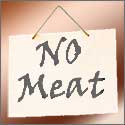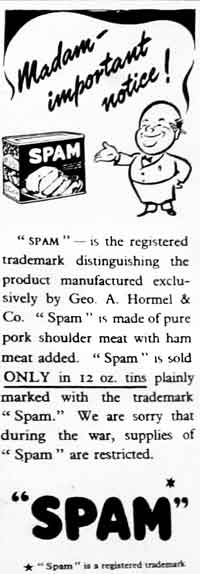Nutritious meals from the tiny UK meat ration in WW2

Meat was rationed in the UK between March 1940 and 4 July 1954 - that is for almost 15 years! – ending almost ten years after the end of the Second World War. So women became creative at using small amounts of meat as effectively as possible. This page describes their recipes and techniques. It also includes look-alike no-meat meals, Spam and some rather unpalatable alternatives to regular meat. Other pages describe ways of obtaining extra meat by keeping chickens and rabbits and with shooting parties for wild game.
____
By the webmaster: her childhood recollections with contributions from others who lived at the time
How the meat ration worked
Meat rationing was unlike the rationing for most other commodities, in that what a given number of coupons could buy depended on the quality and availabity of the meat. So, for any given number of coupons, the public could either buy a small weight of - say - fillet steak, or a relatively large amount of - say - scrag - all subject to availability of course. Often the cheaper cuts had the best flavour but they needed the skill of the cook to prevent them being tough.
Ways to bulk out the meat ration
Gravies and meat fats could be used with other foods to create the taste of meat. Today, stock cubes come in a variety of flavours, but as far as I remember, the only stock cubes available in WW2 were the beef ones. They were simply known as just Oxo and were widely used without meat to give the taste of meat.
Another flavoursome alternative were bones which could be bought from the butcher and cracked open to get to the nutritious bone marrow.
Pearl barley
contributed by Marion Cole
Pearl barley was used a lot to pad out stews.
Dumplings
contributed by Peter Johnson
My mother would get some fresh lard from the butchers and mix it with flour and water, mould into a round tennis ball shapes and drop them into the stew to make it go further. The results were known as dumplings.
Bread and dripping
contributed by Pamela Brierley
My mother would scrape the dripping that was left in the bottom of the tray that the Sunday roast had been in. We had it on Mondays, spread on toast with loads of salt.
Look-alike meat meals with no meat
No-meat shepherds pie 1
contributed by Jan Clifford
My mother created shepherds pie without having to use any of the strictly rationed meat. The potato topping was not a problem as potatoes were not too difficult to obtain. The 'meat', however, was composed of stale bread (nothing was ever wasted) to which was added dripping along with 'Oxo' (beef extract cubes) and anything else that was available.
No-meat shepherds pie 2
contributed by Peter Johnson
Our no-meat shepherds pie was mashed potato on a base of either Bisto or Oxo gravy made very thick with water on the bottom of a baking tray. This was baked in the oven until the gravy was judged to have gone solid.
Almost no-meat shepherds pie 3
contributed by Peter Johnson, amateur historian
A type of shepherds pie could be made with mashed potato and scraps of meat, like the odd rabbit and pigeon that we caught. Meat from this source was not easy to prepare but we were used to it.
Meat you have probably never eaten and would not consider eating
Horse meat and whale meat
contributed by Peter Johnson
Any form of meat was welcome in the rationing and shortages of WW2. Horse meat and whale meat were available from time to time. I have eaten both.
Brawn
My gran would use bits from cow heel and pigs' feet, to make brawn. The bits were stewed then mixed with jelly and put into a mould to set. It was served in slices. I can see her now sucking off the jelly!
Tripe
contributed by John Cole, personal recollections
My mum would eat tripe - the stomach lining of animals like cows, pigs, sheep, and goats -with lots of vinegar and pepper - eurghh.
Processed meat from America - SPAM
Spam and how to eat it
contributed by Peter Johnson
Spam was a precooked meat product which came from America in tins which were opened with a metal turn key. Spam could be eaten straight from the tin, sliced with chips or a salad. The best way to eat it, in my view, was cut into slices, dipped in flour and water and deep fried. (Incidentally English girls who went with American soldiers were also known as Spam.)

Magazine advert for Spam. Photographed at Tilford Rural Life Centre 1940s event
Transcription
"SPAM" is the registered trademark distinguishing the product manufactured exclusively by Geo A Hormel Sc Co. "Spam" is made of pure pork shoulder meat with ham meat added. " Spam" is sold ONLY in 12 oz tins plainly marked with the trademark "Spam". We are sorry that during the war, supplies, of "Spam" are restricted.
Meals without meat
Housewives' creativity meant that there were many different ways that full meals could be made without meat for protein.
Cheese and eggs supplied protein but they were rationed. However, they could be bulked out with vegetables. From today's point of view, you might think that there are numerous snacks that don't contain meat, but there were no snacks in WW2, only women's creativity with meals from next-to-nothing apart from vegetables.
The vegetarian option
contributed by Marion Cole
Mashed potato with grated on-ration cheese mixed in was a standard meal.
Efforts to augment the meat ration
Keeping chickens and rabbits in back gardens was a common practice to obtain extra meat, more of which on their own pages.
contributed by Michael Sullivan
If you heard of the occasional rabbit going, perhaps from a shooting party, you immediately set off to get one, perhaps walking miles. My mother used to go on her bike with my baby sister strapped into a seat on the back.
Nothing was thrown away. After the occasional chicken, there was chicken soup for several days afterwards. I still can't bear chicken soup!
Finally there was the illegal black market through which people could buy almost anything if they knew how to get into it, were prepared to pay over the odds for it, and could keep it hidden from the law. I never knew anyone who used it - unless of course they kept quiet about it for obvious reasons.
| sources | webmaster | contact |
Text and images are copyright
If you can add anything to this page or provide a photo, please contact me.



